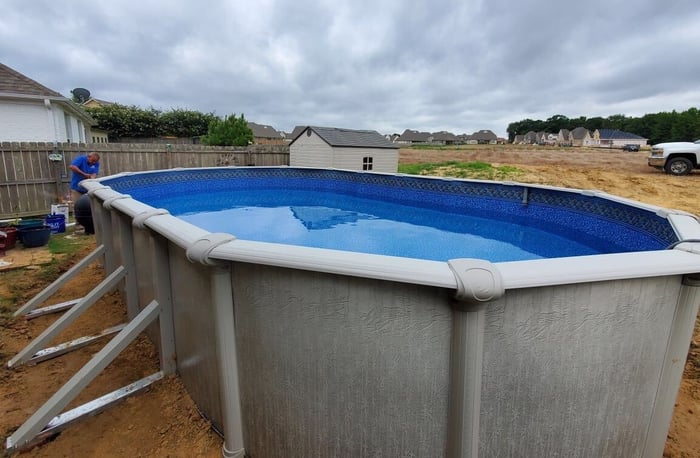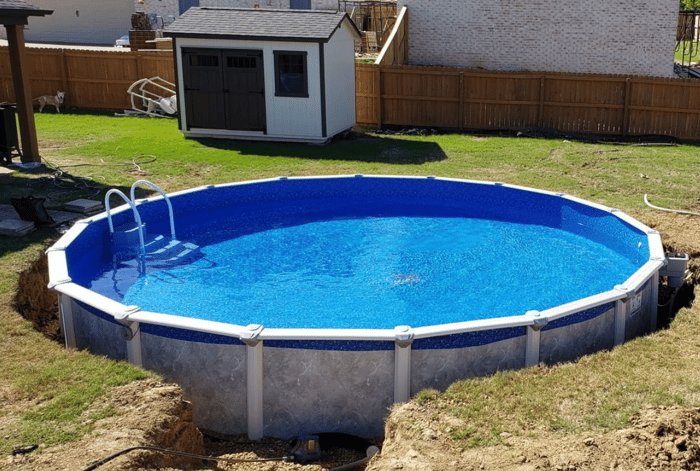When you're building your swimming pool, one important aspect to think of is what you will build your swimming pool bottom out of. While many options exist, some are better than others. And if you want your pool to last, building a strong foundation for it to sit on is one of the most important aspects of any swimming pool installation.
Vermiculite:
For over thirty years, vermiculite has been used in the construction of vinyl liner swimming pools. Essentially after the walls of the pools are positioned, vermiculite is mixed with Portland cement and then troweled on the "bottom" of the pool in both the shallow and deep sections. You have to mix a two to one ratio. These vermiculite pool bases or pool bottoms offer a number of advantages, which protect you and your pool. Used for in-ground and sometimes above ground swimming pools to provide a smooth pool base. Pool Crete Premix
Pool Crete Premix
Pool crete premix is a quality blend of vermiculite, portland cement, and is designed for ease of use - just add water and trowel to form a long-lasting hard bottom for vinyl-lined swimming pools. No mixing of materials required. Pool Crete is a porous but rigid liner base which offers numerous benefits to both the pool installer and the pool owner. With no waste and minimal clean up, this professional approach to hard bottom installations results in greater customer satisfaction. This is a major help for installers and DIY home owners alike. With the premix option it helps eliminate any overage in materials making for a more efficient build.
 Sand/Cement Grout Mixes
Sand/Cement Grout Mixes
Sand/Cement grout mixes produce a concrete that is not porous, and that will not let water pass through it when hydrostatic pressures build up under the bottom of your pool. No water needed for this , just keep it at a four to one ratio and mist it when done to help it set. Sand/cement concrete does provide more compressible strength than vermiculite concrete (2000 psi or more compared to 100 psi for vermiculite concrete.) This option is also environmental friendly if you have any sand overage you can just disperse it throughout your yard.
Packed Sand
Packed sand is the simplest and least expensive media to use for a pool bottom but also the weakest. This media is mainly used in flat bottom swimming pools. This is the softest of the types of pool bottoms subject to leaving imprints. This can be countered with a pool bottom pad like Gorilla Pad or Armor Shield Liner Pad. Changes in the water table can create hydro-static pressures strong enough to break through the base. This can result in wash outs of the floor, and lumps of sand settling under the liner.
TIP: Have all pool floor materials delivered as close to the pool as possible, to reduce workload.
How to Decide Which Pool Floor Material to Use
Your floor choice should be based on availability and ground conditions. Wet, expansive soils or areas with a high water table are better off with a Vermiculite pool base.
Rocky, dry soils require a thicker base, and we would recommend using a sand and cement pool floor mix for these conditions. In some areas of the country pre-mix and vermiculite are not as easily found, and shipment of 60 bags of pre-mix can really add to the cost of your pool floor. In this case, a pool base of sand and cement is usually the best choice.
If you are trying to save money on your pool project, and have dry soils, a low water table and good drainage around the pool, a masonry sand floor can be used.
Common Tools Used
- Shovels
- Trowels -- approximately 4" x 12" round-edged and flexible
- Mortar Mixer (5 cubic foot capacity or larger)
- Five Gallon Bucket
- Wheelbarrow




